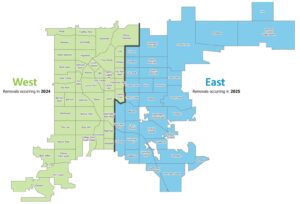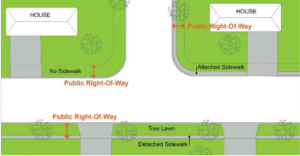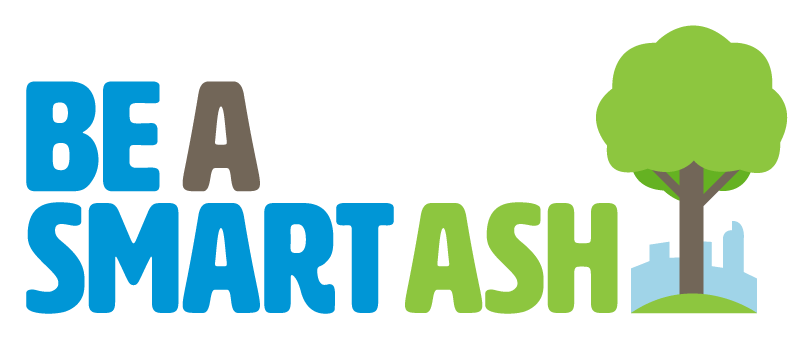Because they’re easy to grow here, nearly one in six trees in Denver is an ash. But ash trees are at risk for an invasive insect called the Emerald Ash Borer (EAB) which can kill trees. Early intervention is a strong defense and removing small, poor condition and dead ash trees slows the spread of the destructive insect by providing less potential habitat.
In 2020, Denver’s Office of the City Forester created a no-cost program to remove and replace small, poor condition and dead ash trees in the public right-of-way (PRW).
Removing and replacing ash trees is another tool Denver’s Office of the City Forester is utilizing to prepare for EAB, thereby increasing the resiliency of Denver’s urban forest. Please read information about the program below and contact the Officer of the City Forester at tree@denvergov.org if you have any additional questions.
The Ash Removal & Replacement Program will operate on the west side of Denver in 2024 and the east side of Denver in 2025 (see map below).

Ash trees that are in declining or dead condition, are one foot (12 inches) or less in diameter (about the diameter of a 5-gallon bucket), and are located in the public right-of-way (PRW) may be eligible for this program. The PRW is the area between your property line and the street, owned by the City of Denver. The PRW typically has the following layouts, but the size of the PRW will vary at each property:

Not sure if you’re eligible? Check out our decision tree to determine if you qualify.
BASA-PRWOptions-VersionA-2024-02-23Why will these ash trees be removed?
The ash trees are at risk for an invasive insect called Emerald Ash Borer (EAB) which can kill trees. Early intervention is a strong defense and removing small, poor condition and dead ash trees slows the spread of the destructive insect by providing less potential habitat.
I’ve applied. When will my ash tree be removed?
The Ash Removal & Replacement Program will operate on the west side of Denver in 2024 and the east side of Denver in 2025 (see map below). The Office of the City Forester will need to evaluate your tree to determine if it qualifies for the program. This process can take a few months to perform and needs to be done when the leaves are on the tree. Residents who apply and are approved for the program should provide their contact information in their application to receive up-to-date information about the process timeline.

I’ve been approved to have my ash tree removed. What happens next?
Once contracted, the Office of the City Forester will notify you via email. Program updates are typically sent through email from tree@denvergov.org. Check both your inbox and spam folder to make sure you do not miss an important update. Contracted trees are typically removed within one to three months. If you have requested a replacement tree, it will be planted in the spring or fall planting season following removal.
What about the stump?
The tree and the stump are removed by Office of the City Forester contractors. Often, contractors remove the bulk of the tree and then come back later to grind the stump.
Can my other trees be removed?
All ash trees in the public right-of-way of each property will be assessed for removal through our program. Other species of tree do not qualify for this program.
Can you remove my private property ash tree?
No, only ash trees in the public right-of-way are eligible for this program.
Can I treat my ash tree?
It is best to remove a declining ash tree while it is small and plant a replacement tree of a different species that is a better long-term viable option. If your ash tree is larger and in good condition, you can click here to learn more about treatment options.
How do I apply for a replacement tree?
Please indicate that you would like a free replacement tree on the postage-paid postcard you will receive from the Office of the City Forester.
Do I have to apply for a replacement tree?
Only residents who indicate they want a replacement tree in their application will be assessed for tree planting. Property owners may opt out of our free tree program when they submit their application. However, there are many benefits to new trees and the new tree will be at no cost to the applicant.
What type of tree will be planted as a replacement?
It depends on availability, so the Office of the City Forester cannot guarantee any specific species. However, our Office of the City Forester team select trees that are best suited for the location. Trees are selected from this list of city-approved street trees.
When will a replacement tree be planted?
Replacement tree(s) are planted in the spring or fall planting season following removal. Spring planting typically occurs from March to May and fall planting from September to October.
Will the new tree be planted in the same spot?
Possibly, but any new trees must meet the Office of the City Forester’s spacing requirements, and our arborists will determine planting locations based on distance from stop signs, water meters, driveways, etc. Click to learn more about the space needed in the public right-of-way. If the ash tree removed did not meet our spacing requirements, we will need to change the planting location. In rare cases, replacement isn’t possible due to spacing restrictions. We try our best to determine this before removal.
Can I get more than one tree planted?
If space permits and conditions are favorable, the Office of the City Forester can approve additional trees at a property. If there is room for three or more trees, we take a phased approach and ask that residents apply for additional trees again in one to two years.
Will you plant on my private property?
No, the Office of the City Forester only plants in the public right-of-way.
Can I reuse my tree?
If you’re interested in reusing your newly removed ash tree, there are many resources to get you started.
